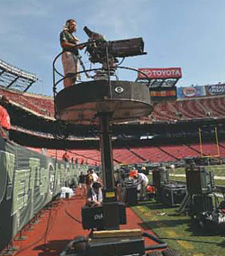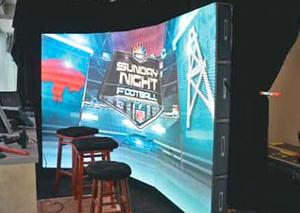Broadcasters Tweak NFL Coverage
TORONTO
If the last several football seasons were a time of HD innovation and expansion for U.S. broadcasters, the upcoming one appears to be the year where they consolidate last season’s gains. Based on conversations with ESPN/ABC, CBS and NBC, the networks are focused on making what they have work better, improving the HD systems they already have in place, and making some small tweaks to enhance their on-air presentations.
CBS: WORKING OUT KINKS
With HDTVs now in more than half of all American homes, CBS Sports is taking stock of its live HD broadcast production. “As a result, most of the stuff we’re doing this year is ‘under the hood’,” said Harold Bryant, vice president of production for CBS Sports. “We’re trying to make the HD production process we have in place run more efficiently and smoothly.”

In particular, CBS Sports is eliminating the last vestiges of videotape in its live football coverage. “This year, we will be pulling our ‘Best Plays of the Game’ material back to New York for storage on an Avid-compatible EVS server, rather than recording it on tape,” Bryant says. “This ‘black box’, as I call it, will let us access and edit this video using our Avid systems directly. No longer will we have to drag and drop files using an Avid Transfer Manager; the footage will go from fibre directly into Avid, thus cutting a step out of our workflow and saving us time.” CBS Sports is also moving from tape archiving to NAS digital storage, “allowing us to get rid of stacks of tapes.
For graphics, “we are also working to improve our bit rate from 40 to 80, allowing our on-air graphics to become crisper looking,” Bryant said, adding that for audio, “although we are 5.1 across the board, I want to perfect our production process. Right now, the audio levels between games are not balanced with each other. This can cause problems on-air, when we cut from one live feed to another. I want to create a standard set of levels to eliminate this.”
And the Next Big Thing at CBS Sports? “We would like to create some kind of ‘Virtual Instant Replay,’ where you could rotate the camera view around the play in three axes,” Bryant said. “This would allow the view to see what happened from all angles. Some experiments have been done in this area, but we’re not at the point yet where we can do this on air. But this, along with 3D HD, is something we’d like to see in the future—just not right now.”
ESPN’s NEW DASHBOARD
For ESPN, which has been wrestling with changes to its Monday Night Football (MNF) Dashboard, the devil is in the details. ESPN launched its dashboard—which lists teams, scores, player stats and other critical data during the game—last season.
This year’s new-and-improved MNF Dashboard is quite a departure from what’s come before. In place of the functional black-and-red dashboard of last season—which was anchored firmly to the bottom of the screen—is a new multi-colored, floating metallic dashboard. Stylistically, the new graphic is a balance between style and minimalism; providing data without dominating the screen.
According to Mike “Spike” Szykowny, ESPN’s senior director of graphics design and development, the new MNF Dashboard sets the standard for all of ESPN’s on-screen graphics this season. He says the stylistic changes are the result of serious soul-searching at the network.
“Earlier clock and score devices were anchored to the bottom of the screen, and often stacked up data; we wanted to do something cleaner,” he tells TV Technology. “As well, the look of our dashboards seemed too utilitarian; we needed something that better reflected the sophistication and authority of our broadcasts.”

NBC, which had this 6x8 foot LED video wall set up for its 2009 Super Bowl XLIII coverage, adopted it fo this season. One thing is certain: The new ESPN MNF Dashboard is the product of the network’s very best design brains, and is a dedicated attempt to inform viewers while leaving their previous HDTV landscapes as uncluttered as possible. “Now we’ll see if they like it,” Szykowny said.
NBC: INCREMENTAL IMPROVEMENTS
NBC’s 2009 Super Bowl XLIII set was built around a 6x8-foot LED video wall. Supplied by AG Light and Sound, the cube “was capable of displaying very high quality footage,” said Tim DeKime, NBC Sports’ director of football operations. “It looked so good on air that we have decided to make it a regular feature on our 2009-2010 NBC Sunday Night Football Broadcasts.”
NBC is also enhancing its 300 fps “X-Mo” slow motion cameras (made by Inertia Unlimited) for the 2009-2010 season. “These cameras give accurate frame-by-frame coverage of the goal lines and sidelines,” said Ken Goss, NBC’s vice president of sports operations. “We are implementing a new version of the X-Mo that will provide footage that will be a little bit better in quality. As well, we will continue to use Cablecams for overhead shots, plus add a combined Cablecam/Sports Media application. Using a yellow first down line overlaid on the video, this app allows us to track the ball’s location with respect to that line.”
Other advances to watch for: NBC Sunday Night Football is upgrading to Chyron HyperX HD graphics, and will be experimenting with HD RF Steadicams for some of its NFL games. “As the season goes on, we plan to be adding more RF Steadicams,” DeKime said. “They will give us a closer look at the play and add some immediacy.”
NBC Sports hopes to improve set-up time at various NFL venues by deploying single mode fiber, rather than the copper wire most facilities have installed. “Single mode fiber provides better quality audio and video transfer, and takes up to 25 percent less time to get operational,” said John Roche, lead technical manager for NBC Sunday Night Football. “It makes more sense to use it, rather than trying to get installed copper to work with all the adaptors we need for digital HDTV.”
With 2008 the year of the network’s launch for full HD, according to Goss, “this year, NBC Sports wants to streamline our HD productions, to make them easier and quicker to setup, and simpler to manage during the actual broadcasts. We’ve got our feet wet in HD; now we’re working on becoming experts.”
The professional video industry's #1 source for news, trends and product and tech information. Sign up below.
James Careless is an award-winning journalist who has written for TV Technology since the 1990s. He has covered HDTV from the days of the six competing HDTV formats that led to the 1993 Grand Alliance, and onwards through ATSC 3.0 and OTT. He also writes for Radio World, along with other publications in aerospace, defense, public safety, streaming media, plus the amusement park industry for something different.

